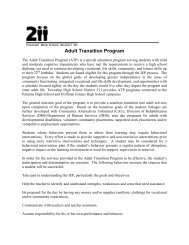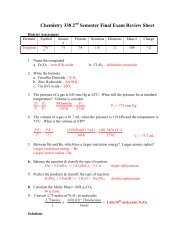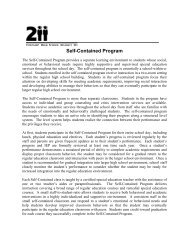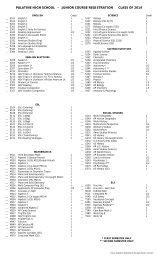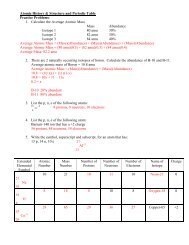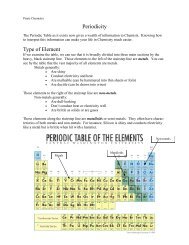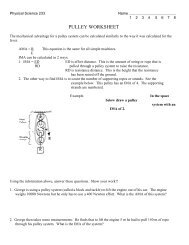You also want an ePaper? Increase the reach of your titles
YUMPU automatically turns print PDFs into web optimized ePapers that Google loves.
The <strong>Dust</strong> <strong>Bowl</strong><br />
&<br />
Migrant Farm Workers<br />
Struggle in the 1930s
The beginning of the Depression…<br />
• In the fall of 1929, the United States began to<br />
fall into an economic depression.<br />
• People, businesses, and even banks lost all of<br />
their money.<br />
• One third of the entire US population did not<br />
have a job.<br />
• Unfortunately, during this time the Plains of<br />
the US experienced a drought; this killed many<br />
crops and many farmers lost their farms.
The <strong>Dust</strong> <strong>Bowl</strong><br />
• 1931 - Severe drought hits the midwestern and<br />
southern plains. As the crops die, the “black<br />
blizzards” begin. <strong>Dust</strong> from the over-plowed<br />
and over-grazed land begins to blow.<br />
Take a look at your map of the <strong>Dust</strong> <strong>Bowl</strong>.<br />
Based on what you know is grown in the<br />
midwest, what kind of crops died?
The drought begins…
1933<br />
• March: When Franklin Roosevelt takes office, the country is in<br />
desperate straits. He took quick steps to declare a four-day<br />
bank holiday, during which time Congress came up with the<br />
Emergency Banking Act of 1933, which stabilized the banking<br />
industry.<br />
• September: Over 6 million young pigs are slaughtered to<br />
stabilize prices With most of the meat going to waste, public<br />
outcry led to the creation, in October, of the Federal Surplus<br />
Relief Corporation. Apples, beans, canned beef, flour and pork<br />
products were distributed through local relief channels.<br />
• October: In California's San Joaquin Valley, where many<br />
farmers fleeing the plains have gone, seeking migrant farm<br />
work, the largest agricultural strike in America's history<br />
begins. More than 18,000 cotton workers with the Cannery<br />
and Agricultural Workers Industrial Union (CAWIU) went on<br />
strike for 24 days.
• When people lost their<br />
farms, they had to leave<br />
to find work elsewhere.<br />
These people became<br />
known as “migrant<br />
workers.”<br />
• Migrant workers<br />
traveled to where ever<br />
there was work. Often,<br />
they could find work<br />
and were very poor.<br />
Migrant Workers
1934<br />
• May: Great dust storms spread from the <strong>Dust</strong> <strong>Bowl</strong><br />
area. The drought is the worst ever in U.S. history,<br />
covering more than 75 percent of the country and<br />
affecting 27 states severely.<br />
• December: The "Yearbook of Agriculture" for 1934<br />
announces, "Approximately 35 million acres of<br />
formerly cultivated land have essentially been<br />
destroyed for crop production. . . . 100 million acres<br />
now in crops have lost all or most of the topsoil; 125<br />
million acres of land now in crops are rapidly losing<br />
topsoil. . . "
The <strong>Dust</strong> Storms<br />
Texas<br />
Oklahoma<br />
Kansas – “Black Sunday
1935<br />
• April 8: FDR approves the Emergency Relief<br />
Appropriation Act, which provides $525<br />
million for drought relief, and authorizes<br />
creation of the Works Progress Administration,<br />
which would employ 8.5 million people.<br />
• April 14: Black Sunday. The worst "black<br />
blizzard" of the <strong>Dust</strong> <strong>Bowl</strong> occurs, causing<br />
extensive damage.
• May: The SCS<br />
publishes a soil<br />
conservation district<br />
law, which, if passed by<br />
the states, allows<br />
farmers to set up their<br />
own districts to enforce<br />
soil conservation<br />
practices for five-year<br />
periods.<br />
1936
1937<br />
• March: Roosevelt addresses the nation in his second inaugural<br />
address, stating, "I see one-third of the nation ill-housed, illclad,<br />
ill-nourished . . . the test of our progress is not whether<br />
we add more to the abundance of those who have much; it is<br />
whether we provide enough for those who have too little."
• The extensive work replowing<br />
the land into<br />
furrows, planting trees<br />
in shelterbelts, and other<br />
conservation methods<br />
has resulted in a 65<br />
percent reduction in the<br />
amount of soil blowing.<br />
However, the drought<br />
continued.<br />
1938
1939<br />
• In the fall, the rain comes, finally bringing an<br />
end to the drought. During the next few years,<br />
with the coming of World War II, the country<br />
is pulled out of the Depression and the plains<br />
once again become golden with wheat.








